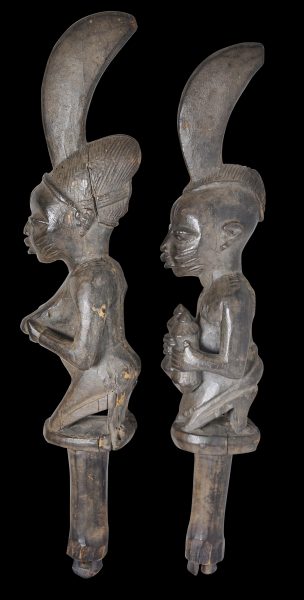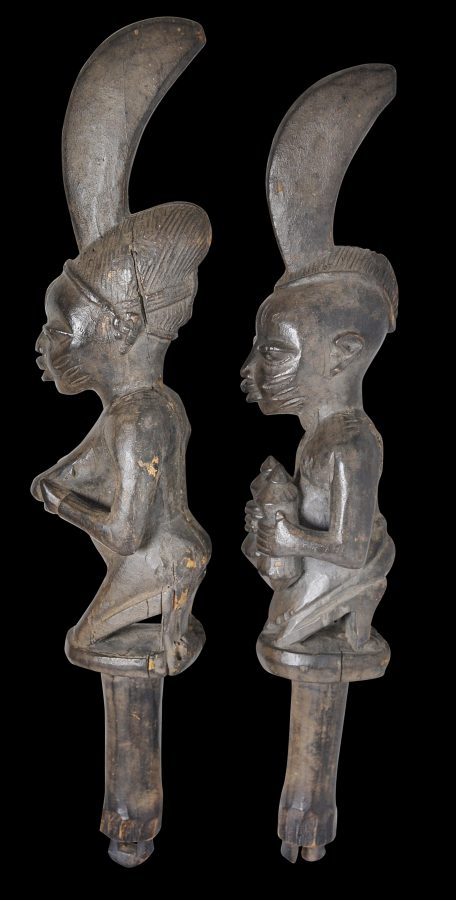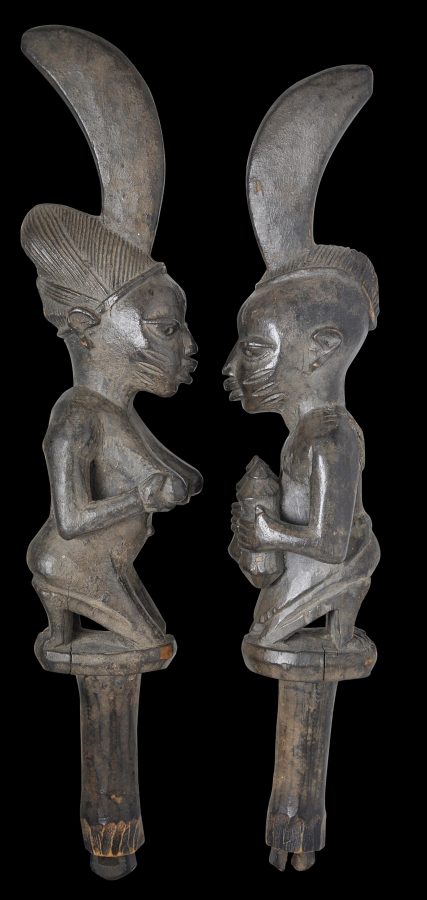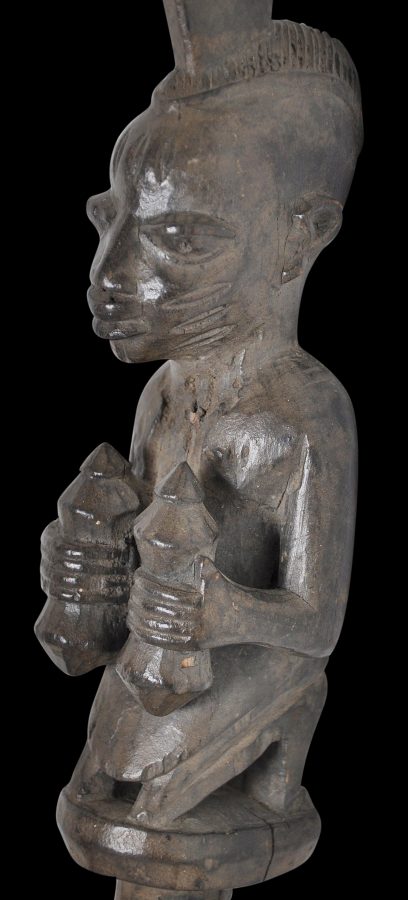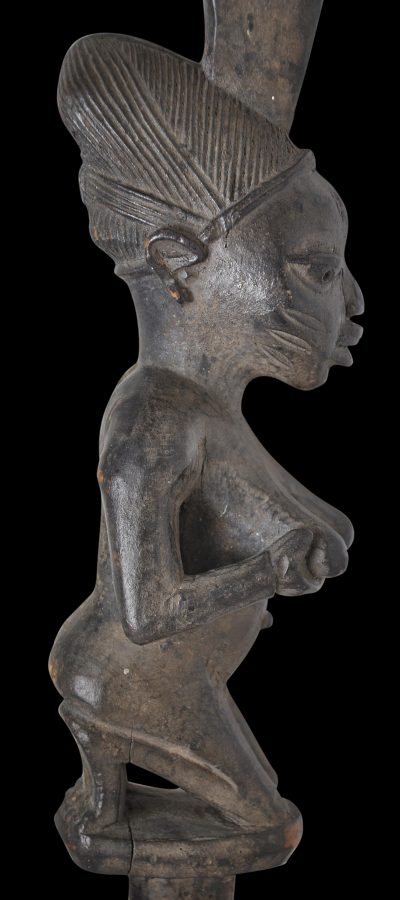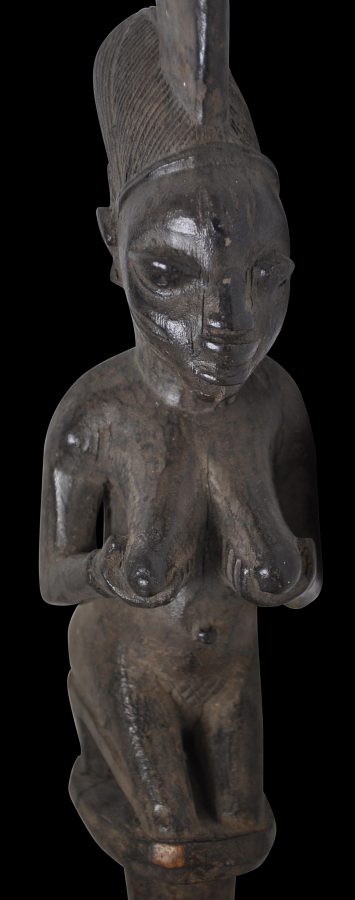Enquiry about object: 3109
Pair of Yoruba Eshu Dance Wands
Yoruba People, Egba/Egbado Tribe, Abeokuta, Nigeria circa 1920
height: (female) approximately 36cm, (male) 34cm; width: (both) approximately 7cm
Provenance
acquired from the estate of Dr Peter Sharratt (d. 2014). Sharratt was a linguist and lecturer in the School of Literatures, Languages and Cultures at the University of Edinburgh who published on Renaissance French sculpture. In his private life, he was an avid collector of tribal art, building up his collection over fifty years. During that time, he bought from UK dealers, collectors and auction houses.
This pair of Eshu wands intended to be gripped by a dancer during Eshu rites is of finely carved, darkened wood and shows a matched male and female couple. The female figure appears to be naked, although there is the suggestion of an upper garment n account of the presence long sleeves. The male figure wears an apron around his waist. In Eshu iconography, female figures tend to be naked but male figures rare are completely naked. Both are depicted kneeling – a symbol of respect and devotion.
The breasts of the female figure are ample and elongated. They are held forward by both hands as if the female figure is offering her milk. The gesture of kneeling and lifting the breasts is well known in Yoruba carving: it is symbol of generosity and ideal femininity. She has a prominent belly button. Her pubic area is incised with cross-hedge patterns. Her coiffure is relatively sophisticated. Her hair is pulled back and raised in a conical shape. It is held together by three bands of hair, raised from the top of her forehead and the top of both of her ears. An ornament holds the three bands of hair at the back of her skull. A double hair band separates her forehead from her coiffure.
The male figure carries in his hands two bottle-shaped gourds (or calabashes) – this is an identifying motif of Eshu. The gourds hold powerful medicine (oogune). His coiffure is that associated with a young male devotee.
Both figures have long, finely carved fingers. Their toes also have been carved in detail. Their buttocks are perky. Their eyes are almond-shaped with prominent eyelids. Their irises are hollow. They have fine noses. Their lips are full and sensual. Three vertical scarifications (pélé) are incised on each of their foreheads. Three horizontal scarifications (àbàjà) are incised on each cheek. They exude an air of serenity.
Figures such as the two here were carved for dance processions and for use in rituals. They have handgrips so that they could be gripped aloft during dance. Clusters of cowry shells would have been tied to the loop at the end of the handgrips.
The figures have no repairs. They do have old, stable shrinkage-related cracking. They have glossy dark patina and obvious signs of use. Matched pairs of Eshu dance wands with significant age are rare.
According to Chemeche (2013, p. 26), Eshu is a trickster who is able to be good and bad, trustful and mischievous, and can deliver prosperity or cause misery. He is the protector of travellers. Most importantly, he is the mediator between the realm of spiritual and mortal worlds. Therefore, he is the guardian of all rituals. He supervises all the sacrifices to the gods. His long phallic coiffure is unique. It symbolises a power that is both creative and destructive. This power allows him to bless those who perform their rituals properly and correctly with good fortune, and to bring misery to those who do not perform their rituals properly. Eshu is therefore often represented on the shrine alongside with other deities. Eshu is especially closely linked to Shango rituals.
The dance wand is carried by young Yoruba devotees on important ritual occasions. It is especially closely linked to the Shango annual festival. Eshu dance wands are very similar in iconography to Shango dance wands, apart from its unique and immediately recognisable phallic coiffure. Female figures on Eshu dance wands are usually young girls but they are mothers with a baby clasped on their backs on Shango dance wands. Also, Eshu dance wands can often be found in pairs whereas no documented evidence can be found for Shango dance wands in pairs. The dance wand is an extraordinary image when seen in the hand of a devotee.
References
Abiodun, R., H. J. Drewal & J. Pemberton III, Yoruba: Art and Aesthetics, The Center for African Art and the Rietberg Museum Zurich, 1991.
Bacquart, J. B., The Tribal Arts of Africa, Thames & Hudson, 1998.
Chemeche, G., Eshu: The Divine Trickster, Antique Collectors’ Club, 2013.
Fagg, W., J. Pemberton III & B. Holcombe, Yoruba: Sculpture of West Africa, Collins, 1982.
Polo, F., Encyclopedia of the Ibeji, Ibeji Art, 2008.
Robbins, W. M. and Nooter, N. I., African Art in American Collections, Smithsonian Institution, 1989.
Walker, R. A., Olowe of Ise: A Yoruba Sculptor to Kings, National Museum of African Art, 1998.


